Teamwork Dynamics: Communication, Ethics, and Strategies for Success
VerifiedAdded on 2020/04/21
|9
|2758
|115
Essay
AI Summary
This essay delves into the multifaceted aspects of teamwork, emphasizing the critical roles of communication and ethics in achieving optimal team performance. It begins by defining teamwork and its significance, then explores communication strategies within teams, highlighting the importance of open dialogue, active listening, and clear objectives. The essay subsequently examines the ethical dimensions of teamwork, including organizational codes of ethics and the impact of ethical behavior on team morale and productivity. It also discusses how ethical leadership influences team members and promotes integrity. The essay provides strategies for effective communication and the importance of ethical conduct, and concludes with recommendations for students, underscoring the value of teamwork in education and future professional settings. The essay draws upon various research sources to support its arguments, offering a comprehensive overview of teamwork dynamics and strategies for success.
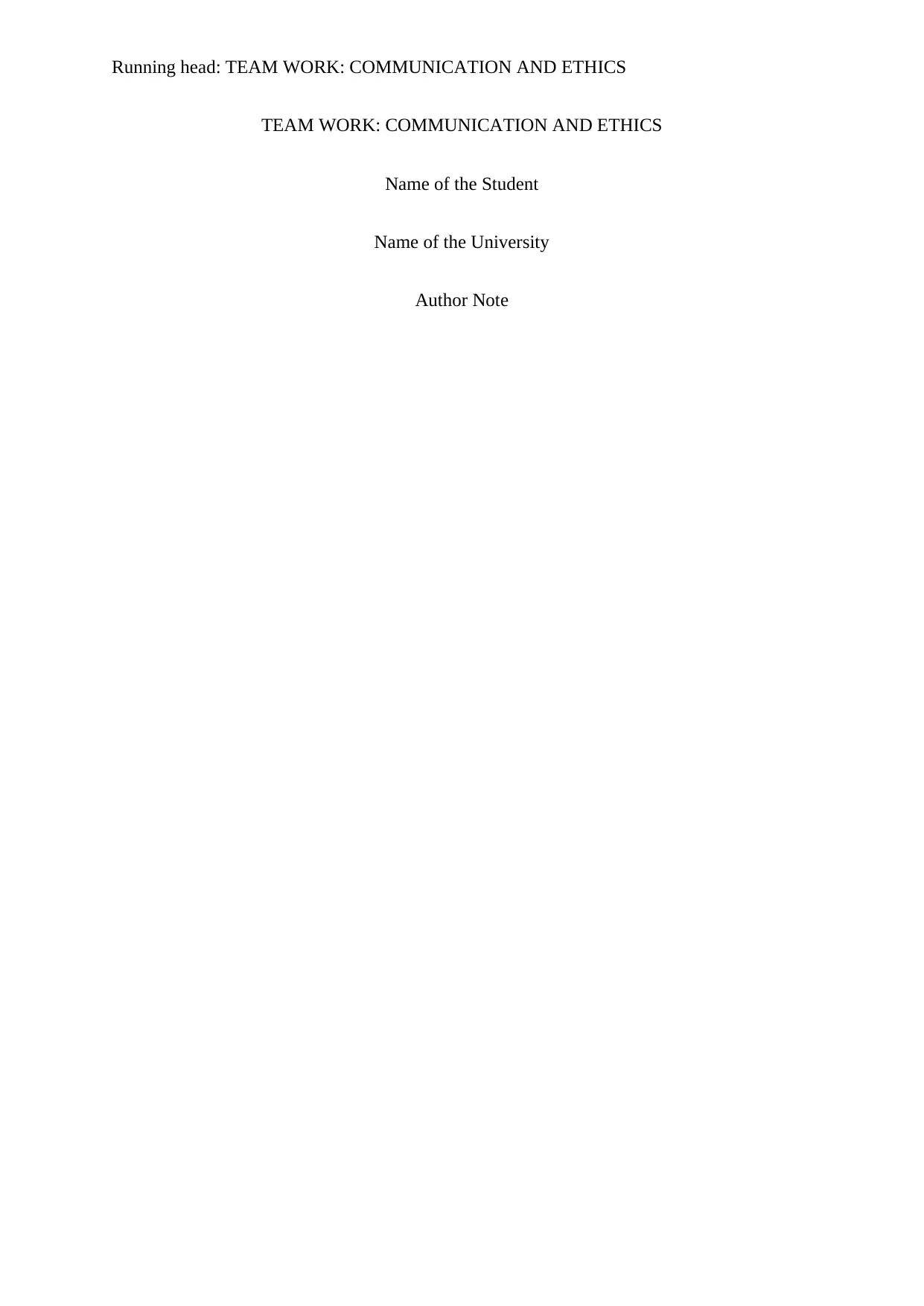
Running head: TEAM WORK: COMMUNICATION AND ETHICS
TEAM WORK: COMMUNICATION AND ETHICS
Name of the Student
Name of the University
Author Note
TEAM WORK: COMMUNICATION AND ETHICS
Name of the Student
Name of the University
Author Note
Paraphrase This Document
Need a fresh take? Get an instant paraphrase of this document with our AI Paraphraser
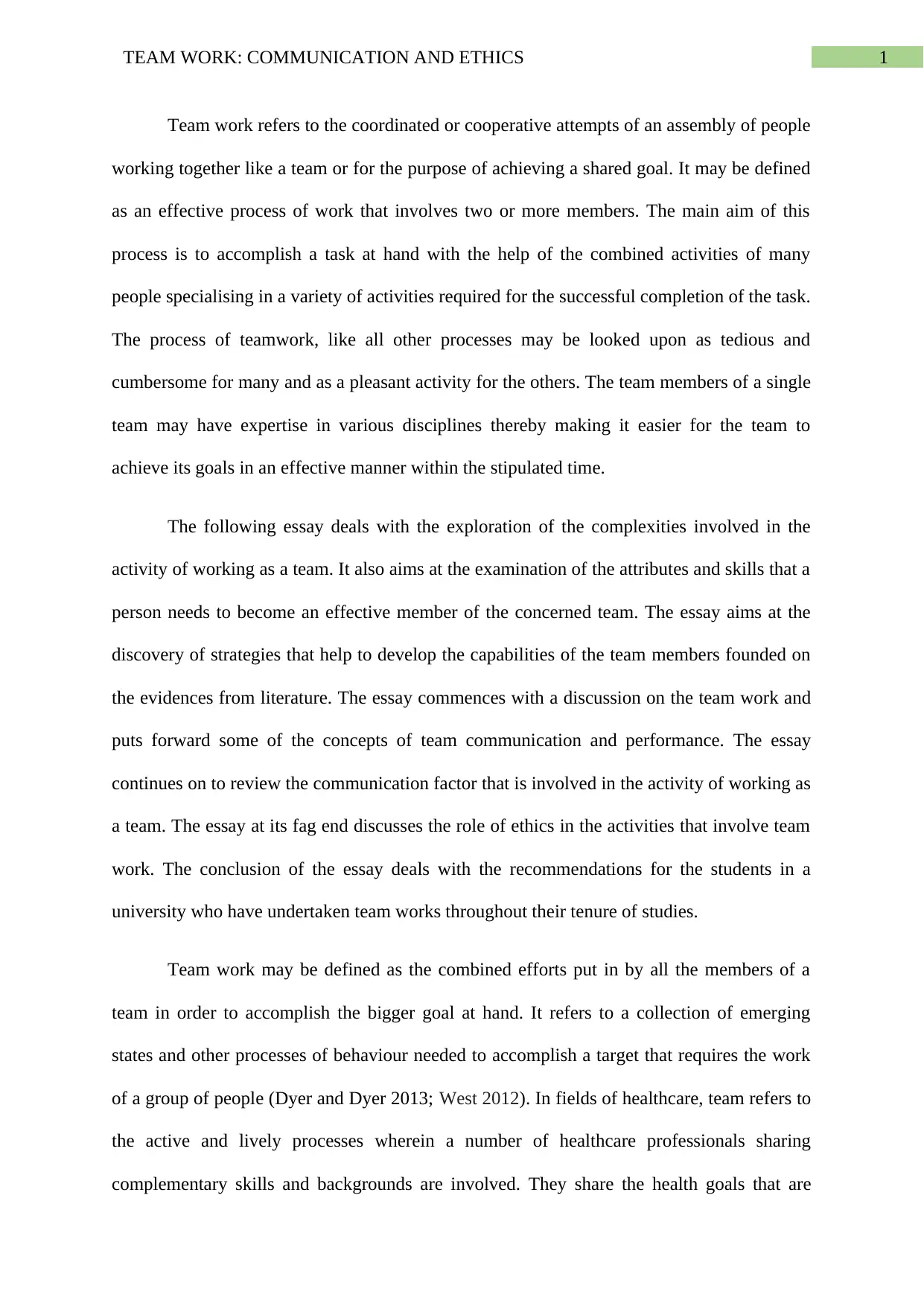
1TEAM WORK: COMMUNICATION AND ETHICS
Team work refers to the coordinated or cooperative attempts of an assembly of people
working together like a team or for the purpose of achieving a shared goal. It may be defined
as an effective process of work that involves two or more members. The main aim of this
process is to accomplish a task at hand with the help of the combined activities of many
people specialising in a variety of activities required for the successful completion of the task.
The process of teamwork, like all other processes may be looked upon as tedious and
cumbersome for many and as a pleasant activity for the others. The team members of a single
team may have expertise in various disciplines thereby making it easier for the team to
achieve its goals in an effective manner within the stipulated time.
The following essay deals with the exploration of the complexities involved in the
activity of working as a team. It also aims at the examination of the attributes and skills that a
person needs to become an effective member of the concerned team. The essay aims at the
discovery of strategies that help to develop the capabilities of the team members founded on
the evidences from literature. The essay commences with a discussion on the team work and
puts forward some of the concepts of team communication and performance. The essay
continues on to review the communication factor that is involved in the activity of working as
a team. The essay at its fag end discusses the role of ethics in the activities that involve team
work. The conclusion of the essay deals with the recommendations for the students in a
university who have undertaken team works throughout their tenure of studies.
Team work may be defined as the combined efforts put in by all the members of a
team in order to accomplish the bigger goal at hand. It refers to a collection of emerging
states and other processes of behaviour needed to accomplish a target that requires the work
of a group of people (Dyer and Dyer 2013; West 2012). In fields of healthcare, team refers to
the active and lively processes wherein a number of healthcare professionals sharing
complementary skills and backgrounds are involved. They share the health goals that are
Team work refers to the coordinated or cooperative attempts of an assembly of people
working together like a team or for the purpose of achieving a shared goal. It may be defined
as an effective process of work that involves two or more members. The main aim of this
process is to accomplish a task at hand with the help of the combined activities of many
people specialising in a variety of activities required for the successful completion of the task.
The process of teamwork, like all other processes may be looked upon as tedious and
cumbersome for many and as a pleasant activity for the others. The team members of a single
team may have expertise in various disciplines thereby making it easier for the team to
achieve its goals in an effective manner within the stipulated time.
The following essay deals with the exploration of the complexities involved in the
activity of working as a team. It also aims at the examination of the attributes and skills that a
person needs to become an effective member of the concerned team. The essay aims at the
discovery of strategies that help to develop the capabilities of the team members founded on
the evidences from literature. The essay commences with a discussion on the team work and
puts forward some of the concepts of team communication and performance. The essay
continues on to review the communication factor that is involved in the activity of working as
a team. The essay at its fag end discusses the role of ethics in the activities that involve team
work. The conclusion of the essay deals with the recommendations for the students in a
university who have undertaken team works throughout their tenure of studies.
Team work may be defined as the combined efforts put in by all the members of a
team in order to accomplish the bigger goal at hand. It refers to a collection of emerging
states and other processes of behaviour needed to accomplish a target that requires the work
of a group of people (Dyer and Dyer 2013; West 2012). In fields of healthcare, team refers to
the active and lively processes wherein a number of healthcare professionals sharing
complementary skills and backgrounds are involved. They share the health goals that are
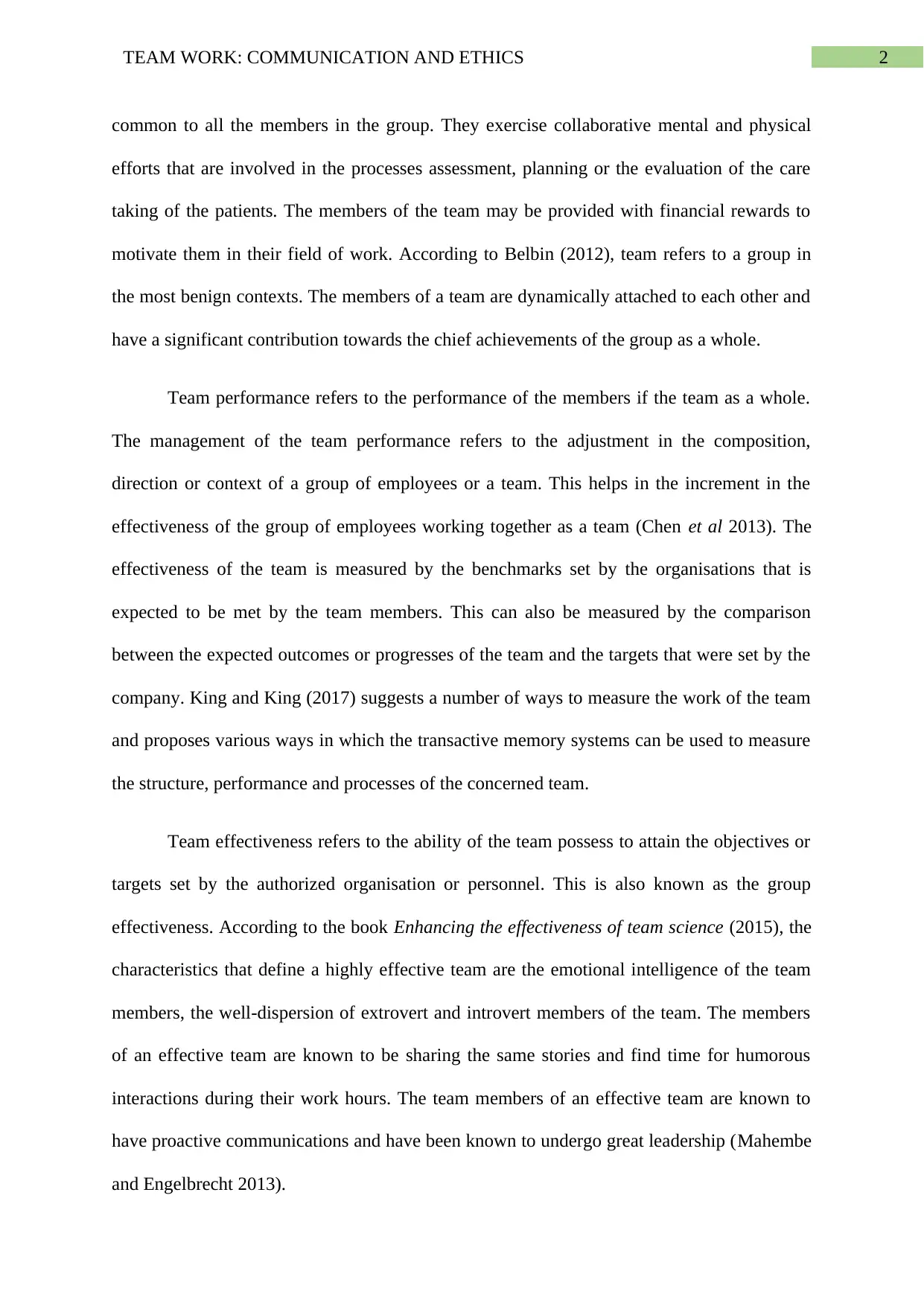
2TEAM WORK: COMMUNICATION AND ETHICS
common to all the members in the group. They exercise collaborative mental and physical
efforts that are involved in the processes assessment, planning or the evaluation of the care
taking of the patients. The members of the team may be provided with financial rewards to
motivate them in their field of work. According to Belbin (2012), team refers to a group in
the most benign contexts. The members of a team are dynamically attached to each other and
have a significant contribution towards the chief achievements of the group as a whole.
Team performance refers to the performance of the members if the team as a whole.
The management of the team performance refers to the adjustment in the composition,
direction or context of a group of employees or a team. This helps in the increment in the
effectiveness of the group of employees working together as a team (Chen et al 2013). The
effectiveness of the team is measured by the benchmarks set by the organisations that is
expected to be met by the team members. This can also be measured by the comparison
between the expected outcomes or progresses of the team and the targets that were set by the
company. King and King (2017) suggests a number of ways to measure the work of the team
and proposes various ways in which the transactive memory systems can be used to measure
the structure, performance and processes of the concerned team.
Team effectiveness refers to the ability of the team possess to attain the objectives or
targets set by the authorized organisation or personnel. This is also known as the group
effectiveness. According to the book Enhancing the effectiveness of team science (2015), the
characteristics that define a highly effective team are the emotional intelligence of the team
members, the well-dispersion of extrovert and introvert members of the team. The members
of an effective team are known to be sharing the same stories and find time for humorous
interactions during their work hours. The team members of an effective team are known to
have proactive communications and have been known to undergo great leadership (Mahembe
and Engelbrecht 2013).
common to all the members in the group. They exercise collaborative mental and physical
efforts that are involved in the processes assessment, planning or the evaluation of the care
taking of the patients. The members of the team may be provided with financial rewards to
motivate them in their field of work. According to Belbin (2012), team refers to a group in
the most benign contexts. The members of a team are dynamically attached to each other and
have a significant contribution towards the chief achievements of the group as a whole.
Team performance refers to the performance of the members if the team as a whole.
The management of the team performance refers to the adjustment in the composition,
direction or context of a group of employees or a team. This helps in the increment in the
effectiveness of the group of employees working together as a team (Chen et al 2013). The
effectiveness of the team is measured by the benchmarks set by the organisations that is
expected to be met by the team members. This can also be measured by the comparison
between the expected outcomes or progresses of the team and the targets that were set by the
company. King and King (2017) suggests a number of ways to measure the work of the team
and proposes various ways in which the transactive memory systems can be used to measure
the structure, performance and processes of the concerned team.
Team effectiveness refers to the ability of the team possess to attain the objectives or
targets set by the authorized organisation or personnel. This is also known as the group
effectiveness. According to the book Enhancing the effectiveness of team science (2015), the
characteristics that define a highly effective team are the emotional intelligence of the team
members, the well-dispersion of extrovert and introvert members of the team. The members
of an effective team are known to be sharing the same stories and find time for humorous
interactions during their work hours. The team members of an effective team are known to
have proactive communications and have been known to undergo great leadership (Mahembe
and Engelbrecht 2013).
⊘ This is a preview!⊘
Do you want full access?
Subscribe today to unlock all pages.

Trusted by 1+ million students worldwide
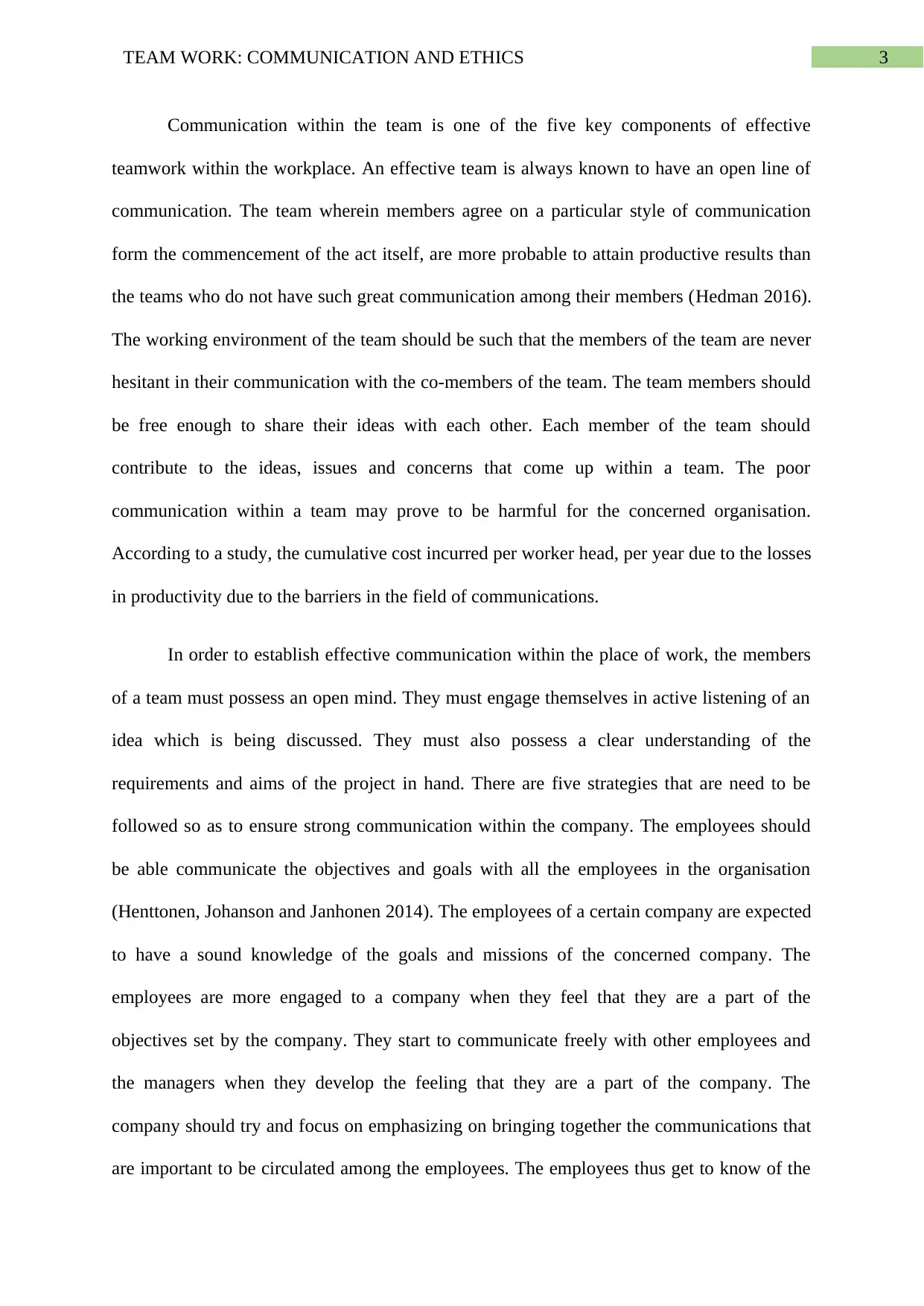
3TEAM WORK: COMMUNICATION AND ETHICS
Communication within the team is one of the five key components of effective
teamwork within the workplace. An effective team is always known to have an open line of
communication. The team wherein members agree on a particular style of communication
form the commencement of the act itself, are more probable to attain productive results than
the teams who do not have such great communication among their members (Hedman 2016).
The working environment of the team should be such that the members of the team are never
hesitant in their communication with the co-members of the team. The team members should
be free enough to share their ideas with each other. Each member of the team should
contribute to the ideas, issues and concerns that come up within a team. The poor
communication within a team may prove to be harmful for the concerned organisation.
According to a study, the cumulative cost incurred per worker head, per year due to the losses
in productivity due to the barriers in the field of communications.
In order to establish effective communication within the place of work, the members
of a team must possess an open mind. They must engage themselves in active listening of an
idea which is being discussed. They must also possess a clear understanding of the
requirements and aims of the project in hand. There are five strategies that are need to be
followed so as to ensure strong communication within the company. The employees should
be able communicate the objectives and goals with all the employees in the organisation
(Henttonen, Johanson and Janhonen 2014). The employees of a certain company are expected
to have a sound knowledge of the goals and missions of the concerned company. The
employees are more engaged to a company when they feel that they are a part of the
objectives set by the company. They start to communicate freely with other employees and
the managers when they develop the feeling that they are a part of the company. The
company should try and focus on emphasizing on bringing together the communications that
are important to be circulated among the employees. The employees thus get to know of the
Communication within the team is one of the five key components of effective
teamwork within the workplace. An effective team is always known to have an open line of
communication. The team wherein members agree on a particular style of communication
form the commencement of the act itself, are more probable to attain productive results than
the teams who do not have such great communication among their members (Hedman 2016).
The working environment of the team should be such that the members of the team are never
hesitant in their communication with the co-members of the team. The team members should
be free enough to share their ideas with each other. Each member of the team should
contribute to the ideas, issues and concerns that come up within a team. The poor
communication within a team may prove to be harmful for the concerned organisation.
According to a study, the cumulative cost incurred per worker head, per year due to the losses
in productivity due to the barriers in the field of communications.
In order to establish effective communication within the place of work, the members
of a team must possess an open mind. They must engage themselves in active listening of an
idea which is being discussed. They must also possess a clear understanding of the
requirements and aims of the project in hand. There are five strategies that are need to be
followed so as to ensure strong communication within the company. The employees should
be able communicate the objectives and goals with all the employees in the organisation
(Henttonen, Johanson and Janhonen 2014). The employees of a certain company are expected
to have a sound knowledge of the goals and missions of the concerned company. The
employees are more engaged to a company when they feel that they are a part of the
objectives set by the company. They start to communicate freely with other employees and
the managers when they develop the feeling that they are a part of the company. The
company should try and focus on emphasizing on bringing together the communications that
are important to be circulated among the employees. The employees thus get to know of the
Paraphrase This Document
Need a fresh take? Get an instant paraphrase of this document with our AI Paraphraser
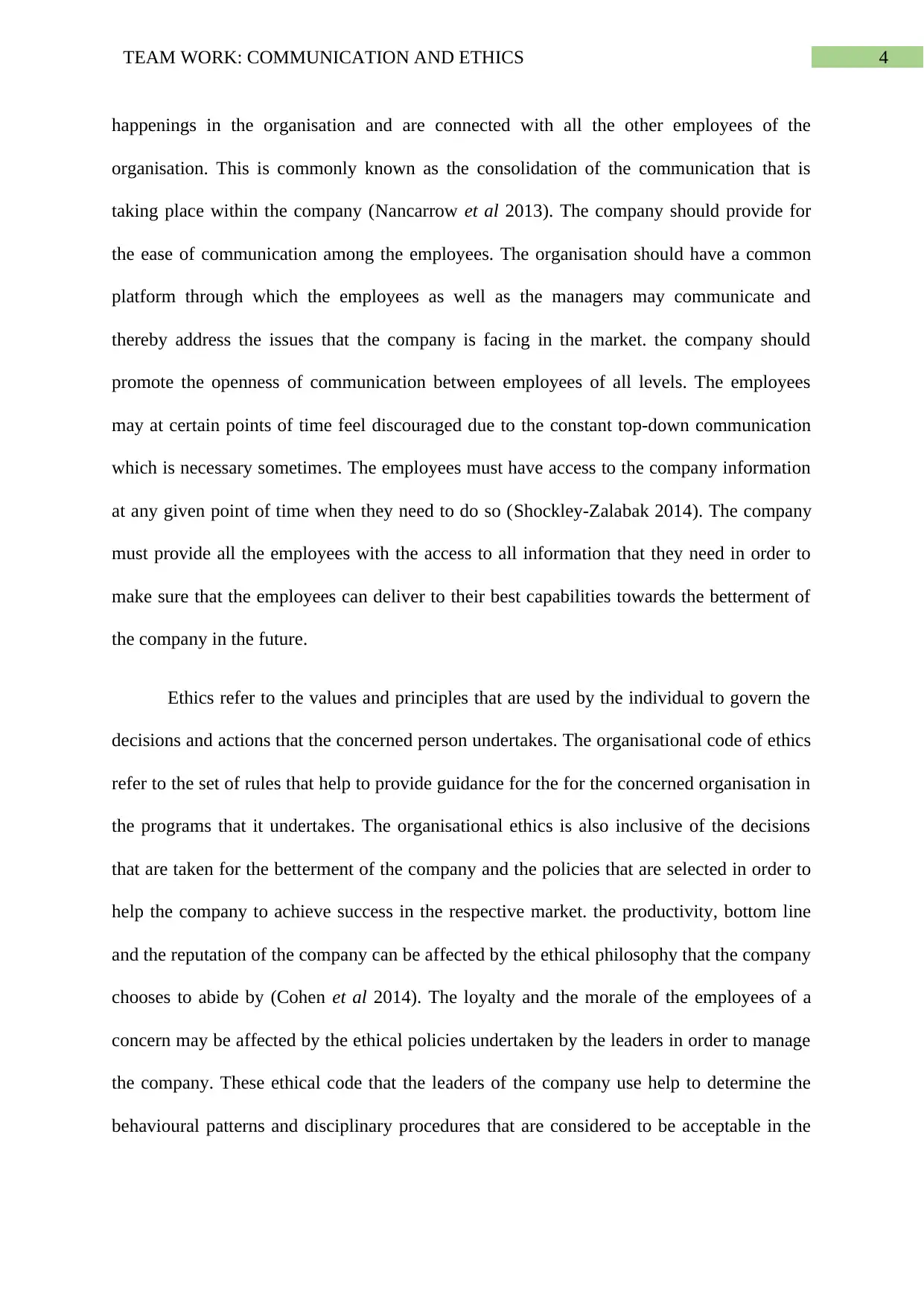
4TEAM WORK: COMMUNICATION AND ETHICS
happenings in the organisation and are connected with all the other employees of the
organisation. This is commonly known as the consolidation of the communication that is
taking place within the company (Nancarrow et al 2013). The company should provide for
the ease of communication among the employees. The organisation should have a common
platform through which the employees as well as the managers may communicate and
thereby address the issues that the company is facing in the market. the company should
promote the openness of communication between employees of all levels. The employees
may at certain points of time feel discouraged due to the constant top-down communication
which is necessary sometimes. The employees must have access to the company information
at any given point of time when they need to do so (Shockley-Zalabak 2014). The company
must provide all the employees with the access to all information that they need in order to
make sure that the employees can deliver to their best capabilities towards the betterment of
the company in the future.
Ethics refer to the values and principles that are used by the individual to govern the
decisions and actions that the concerned person undertakes. The organisational code of ethics
refer to the set of rules that help to provide guidance for the for the concerned organisation in
the programs that it undertakes. The organisational ethics is also inclusive of the decisions
that are taken for the betterment of the company and the policies that are selected in order to
help the company to achieve success in the respective market. the productivity, bottom line
and the reputation of the company can be affected by the ethical philosophy that the company
chooses to abide by (Cohen et al 2014). The loyalty and the morale of the employees of a
concern may be affected by the ethical policies undertaken by the leaders in order to manage
the company. These ethical code that the leaders of the company use help to determine the
behavioural patterns and disciplinary procedures that are considered to be acceptable in the
happenings in the organisation and are connected with all the other employees of the
organisation. This is commonly known as the consolidation of the communication that is
taking place within the company (Nancarrow et al 2013). The company should provide for
the ease of communication among the employees. The organisation should have a common
platform through which the employees as well as the managers may communicate and
thereby address the issues that the company is facing in the market. the company should
promote the openness of communication between employees of all levels. The employees
may at certain points of time feel discouraged due to the constant top-down communication
which is necessary sometimes. The employees must have access to the company information
at any given point of time when they need to do so (Shockley-Zalabak 2014). The company
must provide all the employees with the access to all information that they need in order to
make sure that the employees can deliver to their best capabilities towards the betterment of
the company in the future.
Ethics refer to the values and principles that are used by the individual to govern the
decisions and actions that the concerned person undertakes. The organisational code of ethics
refer to the set of rules that help to provide guidance for the for the concerned organisation in
the programs that it undertakes. The organisational ethics is also inclusive of the decisions
that are taken for the betterment of the company and the policies that are selected in order to
help the company to achieve success in the respective market. the productivity, bottom line
and the reputation of the company can be affected by the ethical philosophy that the company
chooses to abide by (Cohen et al 2014). The loyalty and the morale of the employees of a
concern may be affected by the ethical policies undertaken by the leaders in order to manage
the company. These ethical code that the leaders of the company use help to determine the
behavioural patterns and disciplinary procedures that are considered to be acceptable in the
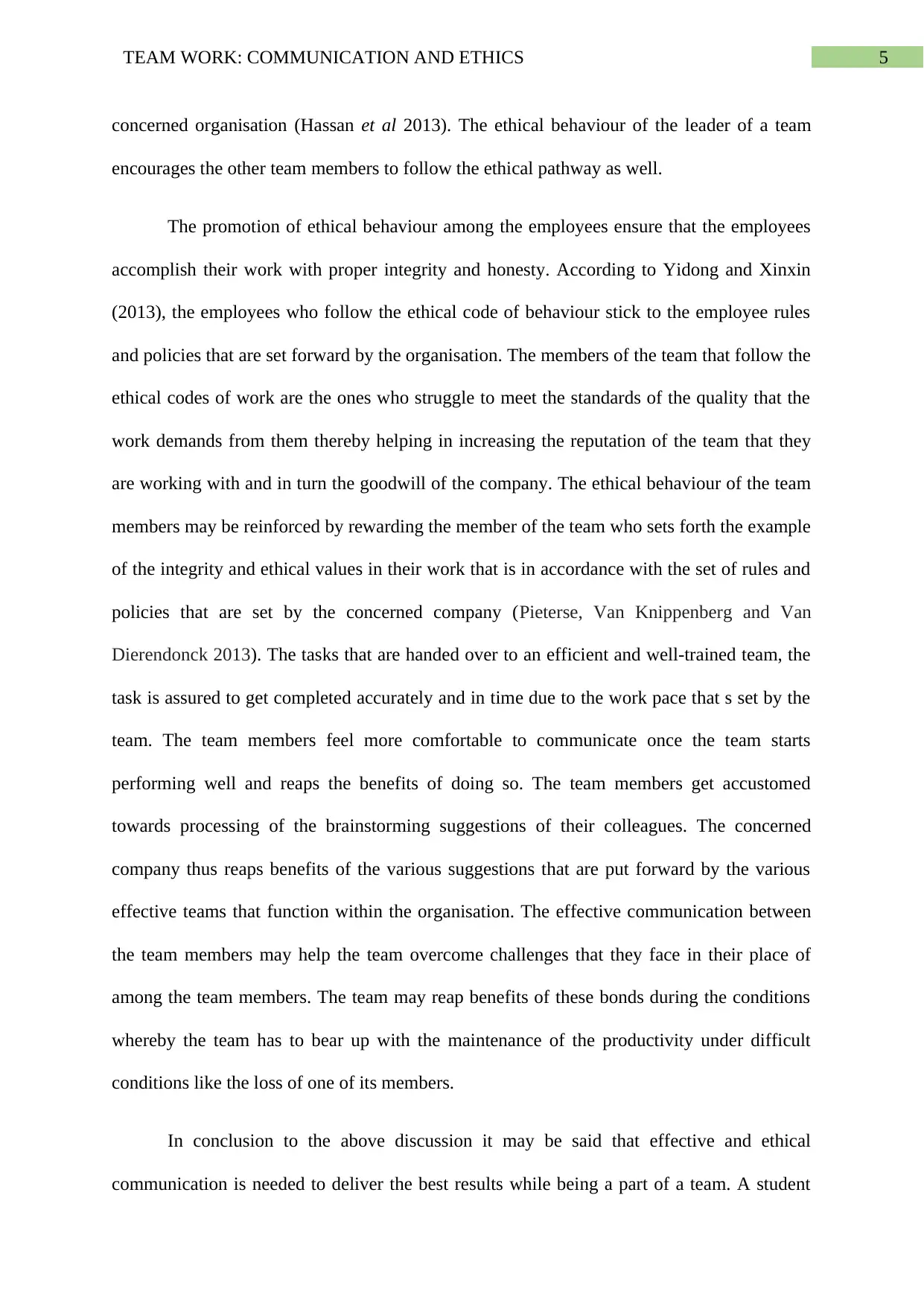
5TEAM WORK: COMMUNICATION AND ETHICS
concerned organisation (Hassan et al 2013). The ethical behaviour of the leader of a team
encourages the other team members to follow the ethical pathway as well.
The promotion of ethical behaviour among the employees ensure that the employees
accomplish their work with proper integrity and honesty. According to Yidong and Xinxin
(2013), the employees who follow the ethical code of behaviour stick to the employee rules
and policies that are set forward by the organisation. The members of the team that follow the
ethical codes of work are the ones who struggle to meet the standards of the quality that the
work demands from them thereby helping in increasing the reputation of the team that they
are working with and in turn the goodwill of the company. The ethical behaviour of the team
members may be reinforced by rewarding the member of the team who sets forth the example
of the integrity and ethical values in their work that is in accordance with the set of rules and
policies that are set by the concerned company (Pieterse, Van Knippenberg and Van
Dierendonck 2013). The tasks that are handed over to an efficient and well-trained team, the
task is assured to get completed accurately and in time due to the work pace that s set by the
team. The team members feel more comfortable to communicate once the team starts
performing well and reaps the benefits of doing so. The team members get accustomed
towards processing of the brainstorming suggestions of their colleagues. The concerned
company thus reaps benefits of the various suggestions that are put forward by the various
effective teams that function within the organisation. The effective communication between
the team members may help the team overcome challenges that they face in their place of
among the team members. The team may reap benefits of these bonds during the conditions
whereby the team has to bear up with the maintenance of the productivity under difficult
conditions like the loss of one of its members.
In conclusion to the above discussion it may be said that effective and ethical
communication is needed to deliver the best results while being a part of a team. A student
concerned organisation (Hassan et al 2013). The ethical behaviour of the leader of a team
encourages the other team members to follow the ethical pathway as well.
The promotion of ethical behaviour among the employees ensure that the employees
accomplish their work with proper integrity and honesty. According to Yidong and Xinxin
(2013), the employees who follow the ethical code of behaviour stick to the employee rules
and policies that are set forward by the organisation. The members of the team that follow the
ethical codes of work are the ones who struggle to meet the standards of the quality that the
work demands from them thereby helping in increasing the reputation of the team that they
are working with and in turn the goodwill of the company. The ethical behaviour of the team
members may be reinforced by rewarding the member of the team who sets forth the example
of the integrity and ethical values in their work that is in accordance with the set of rules and
policies that are set by the concerned company (Pieterse, Van Knippenberg and Van
Dierendonck 2013). The tasks that are handed over to an efficient and well-trained team, the
task is assured to get completed accurately and in time due to the work pace that s set by the
team. The team members feel more comfortable to communicate once the team starts
performing well and reaps the benefits of doing so. The team members get accustomed
towards processing of the brainstorming suggestions of their colleagues. The concerned
company thus reaps benefits of the various suggestions that are put forward by the various
effective teams that function within the organisation. The effective communication between
the team members may help the team overcome challenges that they face in their place of
among the team members. The team may reap benefits of these bonds during the conditions
whereby the team has to bear up with the maintenance of the productivity under difficult
conditions like the loss of one of its members.
In conclusion to the above discussion it may be said that effective and ethical
communication is needed to deliver the best results while being a part of a team. A student
⊘ This is a preview!⊘
Do you want full access?
Subscribe today to unlock all pages.

Trusted by 1+ million students worldwide
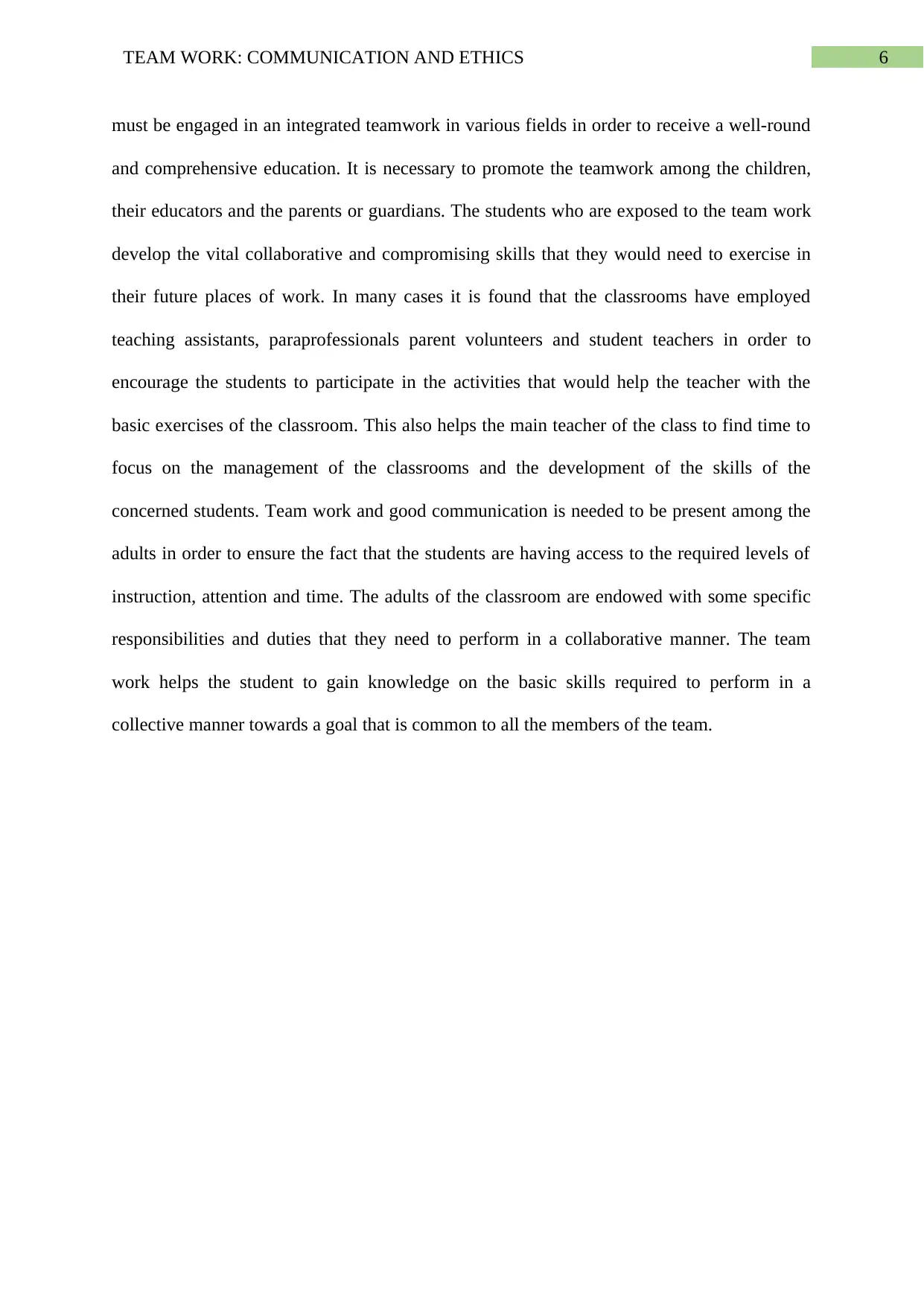
6TEAM WORK: COMMUNICATION AND ETHICS
must be engaged in an integrated teamwork in various fields in order to receive a well-round
and comprehensive education. It is necessary to promote the teamwork among the children,
their educators and the parents or guardians. The students who are exposed to the team work
develop the vital collaborative and compromising skills that they would need to exercise in
their future places of work. In many cases it is found that the classrooms have employed
teaching assistants, paraprofessionals parent volunteers and student teachers in order to
encourage the students to participate in the activities that would help the teacher with the
basic exercises of the classroom. This also helps the main teacher of the class to find time to
focus on the management of the classrooms and the development of the skills of the
concerned students. Team work and good communication is needed to be present among the
adults in order to ensure the fact that the students are having access to the required levels of
instruction, attention and time. The adults of the classroom are endowed with some specific
responsibilities and duties that they need to perform in a collaborative manner. The team
work helps the student to gain knowledge on the basic skills required to perform in a
collective manner towards a goal that is common to all the members of the team.
must be engaged in an integrated teamwork in various fields in order to receive a well-round
and comprehensive education. It is necessary to promote the teamwork among the children,
their educators and the parents or guardians. The students who are exposed to the team work
develop the vital collaborative and compromising skills that they would need to exercise in
their future places of work. In many cases it is found that the classrooms have employed
teaching assistants, paraprofessionals parent volunteers and student teachers in order to
encourage the students to participate in the activities that would help the teacher with the
basic exercises of the classroom. This also helps the main teacher of the class to find time to
focus on the management of the classrooms and the development of the skills of the
concerned students. Team work and good communication is needed to be present among the
adults in order to ensure the fact that the students are having access to the required levels of
instruction, attention and time. The adults of the classroom are endowed with some specific
responsibilities and duties that they need to perform in a collaborative manner. The team
work helps the student to gain knowledge on the basic skills required to perform in a
collective manner towards a goal that is common to all the members of the team.
Paraphrase This Document
Need a fresh take? Get an instant paraphrase of this document with our AI Paraphraser
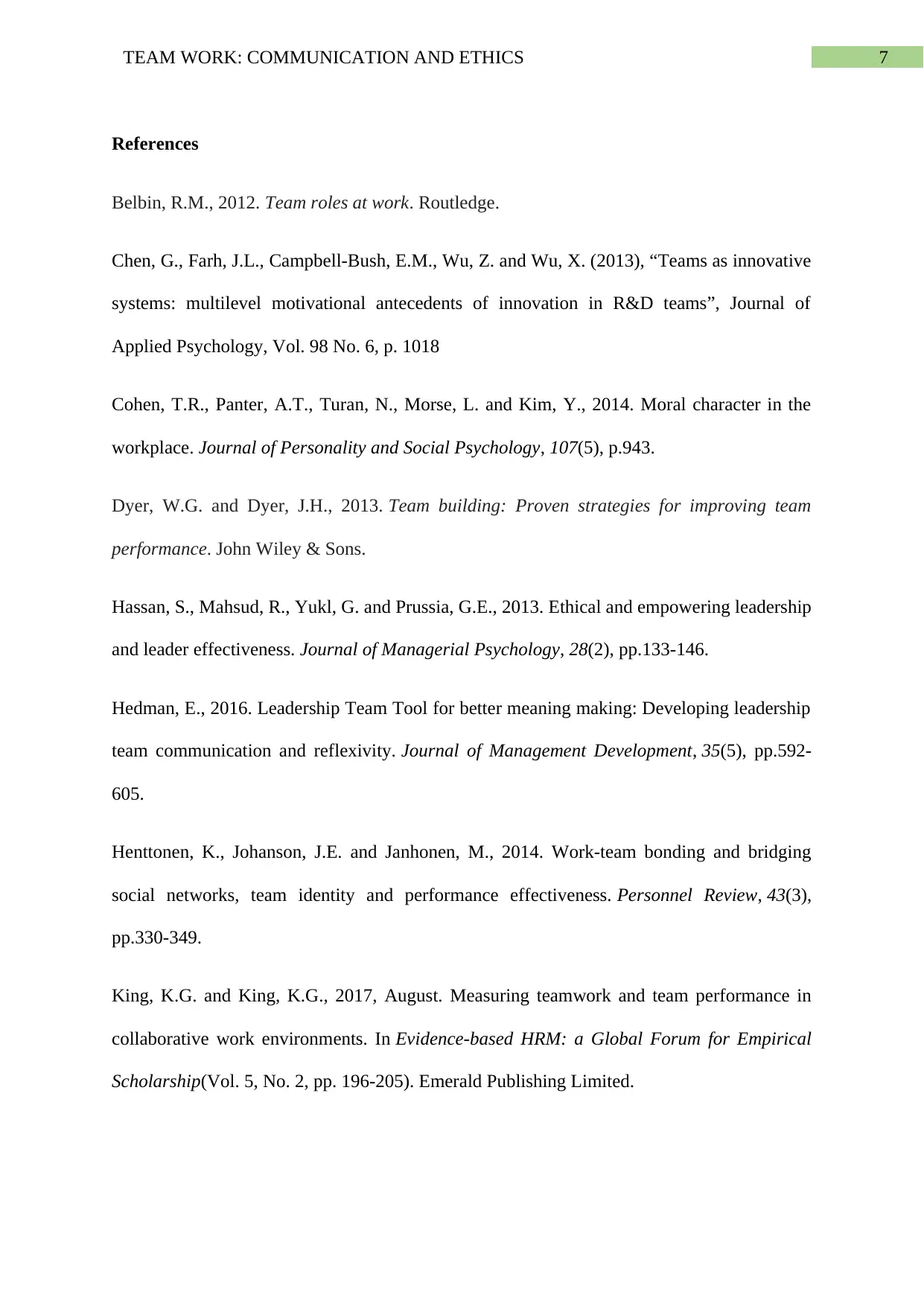
7TEAM WORK: COMMUNICATION AND ETHICS
References
Belbin, R.M., 2012. Team roles at work. Routledge.
Chen, G., Farh, J.L., Campbell-Bush, E.M., Wu, Z. and Wu, X. (2013), “Teams as innovative
systems: multilevel motivational antecedents of innovation in R&D teams”, Journal of
Applied Psychology, Vol. 98 No. 6, p. 1018
Cohen, T.R., Panter, A.T., Turan, N., Morse, L. and Kim, Y., 2014. Moral character in the
workplace. Journal of Personality and Social Psychology, 107(5), p.943.
Dyer, W.G. and Dyer, J.H., 2013. Team building: Proven strategies for improving team
performance. John Wiley & Sons.
Hassan, S., Mahsud, R., Yukl, G. and Prussia, G.E., 2013. Ethical and empowering leadership
and leader effectiveness. Journal of Managerial Psychology, 28(2), pp.133-146.
Hedman, E., 2016. Leadership Team Tool for better meaning making: Developing leadership
team communication and reflexivity. Journal of Management Development, 35(5), pp.592-
605.
Henttonen, K., Johanson, J.E. and Janhonen, M., 2014. Work-team bonding and bridging
social networks, team identity and performance effectiveness. Personnel Review, 43(3),
pp.330-349.
King, K.G. and King, K.G., 2017, August. Measuring teamwork and team performance in
collaborative work environments. In Evidence-based HRM: a Global Forum for Empirical
Scholarship(Vol. 5, No. 2, pp. 196-205). Emerald Publishing Limited.
References
Belbin, R.M., 2012. Team roles at work. Routledge.
Chen, G., Farh, J.L., Campbell-Bush, E.M., Wu, Z. and Wu, X. (2013), “Teams as innovative
systems: multilevel motivational antecedents of innovation in R&D teams”, Journal of
Applied Psychology, Vol. 98 No. 6, p. 1018
Cohen, T.R., Panter, A.T., Turan, N., Morse, L. and Kim, Y., 2014. Moral character in the
workplace. Journal of Personality and Social Psychology, 107(5), p.943.
Dyer, W.G. and Dyer, J.H., 2013. Team building: Proven strategies for improving team
performance. John Wiley & Sons.
Hassan, S., Mahsud, R., Yukl, G. and Prussia, G.E., 2013. Ethical and empowering leadership
and leader effectiveness. Journal of Managerial Psychology, 28(2), pp.133-146.
Hedman, E., 2016. Leadership Team Tool for better meaning making: Developing leadership
team communication and reflexivity. Journal of Management Development, 35(5), pp.592-
605.
Henttonen, K., Johanson, J.E. and Janhonen, M., 2014. Work-team bonding and bridging
social networks, team identity and performance effectiveness. Personnel Review, 43(3),
pp.330-349.
King, K.G. and King, K.G., 2017, August. Measuring teamwork and team performance in
collaborative work environments. In Evidence-based HRM: a Global Forum for Empirical
Scholarship(Vol. 5, No. 2, pp. 196-205). Emerald Publishing Limited.
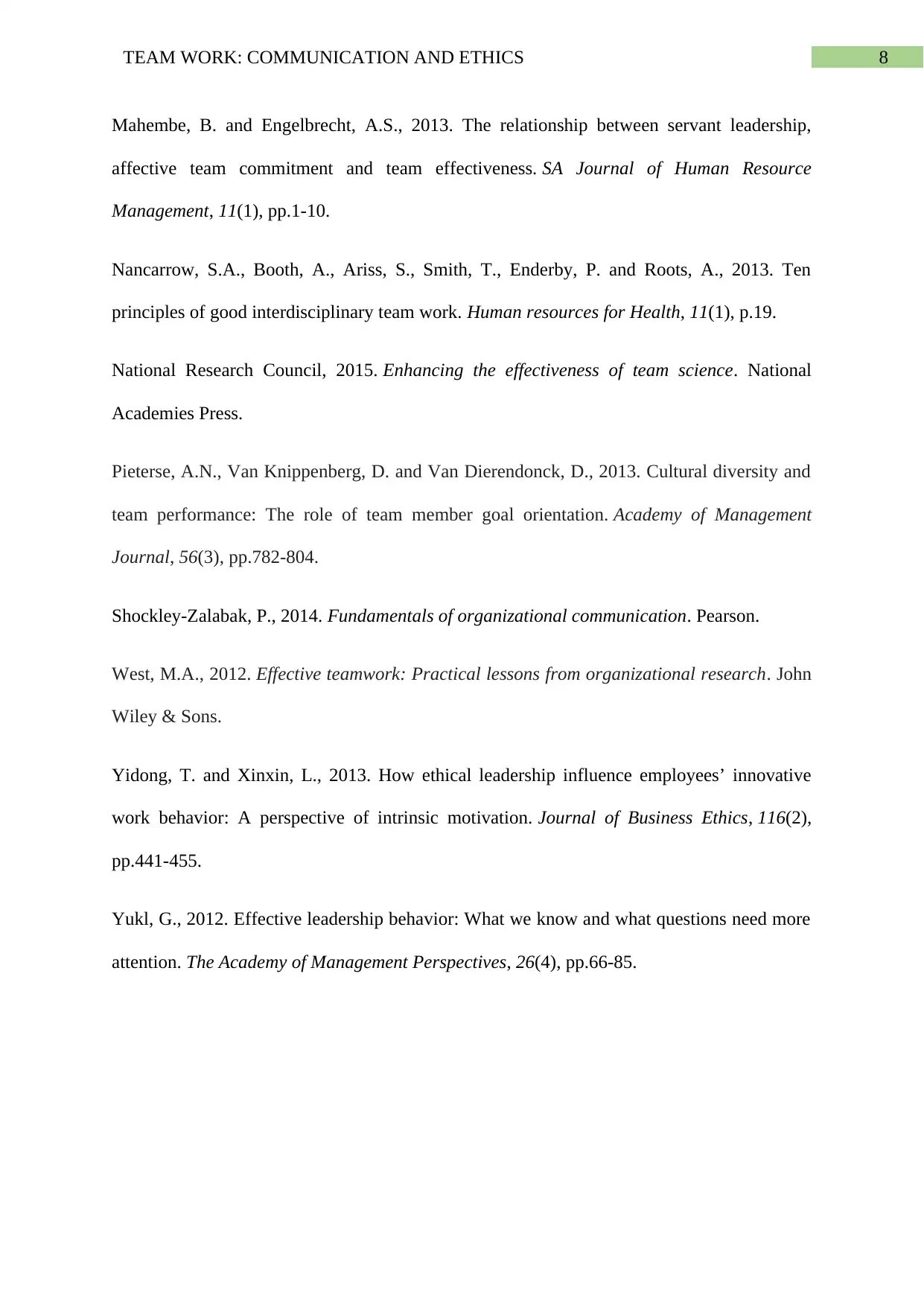
8TEAM WORK: COMMUNICATION AND ETHICS
Mahembe, B. and Engelbrecht, A.S., 2013. The relationship between servant leadership,
affective team commitment and team effectiveness. SA Journal of Human Resource
Management, 11(1), pp.1-10.
Nancarrow, S.A., Booth, A., Ariss, S., Smith, T., Enderby, P. and Roots, A., 2013. Ten
principles of good interdisciplinary team work. Human resources for Health, 11(1), p.19.
National Research Council, 2015. Enhancing the effectiveness of team science. National
Academies Press.
Pieterse, A.N., Van Knippenberg, D. and Van Dierendonck, D., 2013. Cultural diversity and
team performance: The role of team member goal orientation. Academy of Management
Journal, 56(3), pp.782-804.
Shockley-Zalabak, P., 2014. Fundamentals of organizational communication. Pearson.
West, M.A., 2012. Effective teamwork: Practical lessons from organizational research. John
Wiley & Sons.
Yidong, T. and Xinxin, L., 2013. How ethical leadership influence employees’ innovative
work behavior: A perspective of intrinsic motivation. Journal of Business Ethics, 116(2),
pp.441-455.
Yukl, G., 2012. Effective leadership behavior: What we know and what questions need more
attention. The Academy of Management Perspectives, 26(4), pp.66-85.
Mahembe, B. and Engelbrecht, A.S., 2013. The relationship between servant leadership,
affective team commitment and team effectiveness. SA Journal of Human Resource
Management, 11(1), pp.1-10.
Nancarrow, S.A., Booth, A., Ariss, S., Smith, T., Enderby, P. and Roots, A., 2013. Ten
principles of good interdisciplinary team work. Human resources for Health, 11(1), p.19.
National Research Council, 2015. Enhancing the effectiveness of team science. National
Academies Press.
Pieterse, A.N., Van Knippenberg, D. and Van Dierendonck, D., 2013. Cultural diversity and
team performance: The role of team member goal orientation. Academy of Management
Journal, 56(3), pp.782-804.
Shockley-Zalabak, P., 2014. Fundamentals of organizational communication. Pearson.
West, M.A., 2012. Effective teamwork: Practical lessons from organizational research. John
Wiley & Sons.
Yidong, T. and Xinxin, L., 2013. How ethical leadership influence employees’ innovative
work behavior: A perspective of intrinsic motivation. Journal of Business Ethics, 116(2),
pp.441-455.
Yukl, G., 2012. Effective leadership behavior: What we know and what questions need more
attention. The Academy of Management Perspectives, 26(4), pp.66-85.
⊘ This is a preview!⊘
Do you want full access?
Subscribe today to unlock all pages.

Trusted by 1+ million students worldwide
1 out of 9
Related Documents
Your All-in-One AI-Powered Toolkit for Academic Success.
+13062052269
info@desklib.com
Available 24*7 on WhatsApp / Email
![[object Object]](/_next/static/media/star-bottom.7253800d.svg)
Unlock your academic potential
Copyright © 2020–2025 A2Z Services. All Rights Reserved. Developed and managed by ZUCOL.





